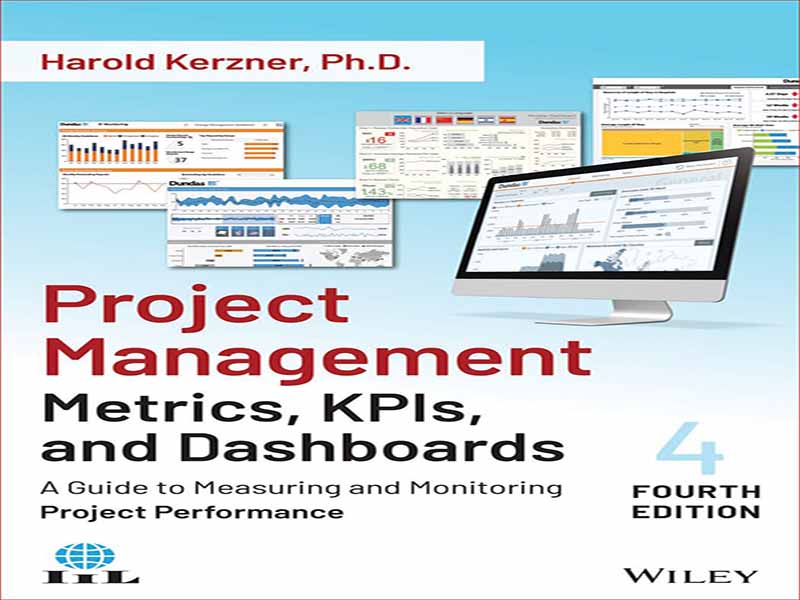- عنوان: PROJECT MANAGEMENT METRICS, KPIs, AND DASHBOARDS
- نویسنده: Harold Kerzner
- حوزه: مدیریت پروژه
- سال انتشار: 2023
- تعداد صفحه: 498
- زبان اصلی: انگلیسی
- نوع فایل: pdf
- حجم فایل: 15.9 مگابایت
هدف نهایی معیارها و داشبوردها ارائه اطلاعات بیشتر نیست، بلکه ارائه اطلاعات مناسب به فرد مناسب در زمان مناسب، با استفاده از رسانه صحیح و به شیوه ای مقرون به صرفه است. این قطعا یک چالش است. با رشد فناوری رایانه، سهولت تولید و ارائه اطلاعات به مدیریت و ذینفعان نیز افزایش یافته است. امروزه به نظر می رسد همه نگران بار اطلاعاتی هستند. متأسفانه، مشکل واقعی، اضافه بار غیر اطلاعاتی است. به عبارت دیگر، گزارشهای بیفایده زیادی وجود دارد که به راحتی قابل خواندن نیستند و اطلاعات زیادی را در اختیار خوانندگان قرار میدهند، که ممکن است بسیاری از آنها هیچ ارتباطی نداشته باشند. این اطلاعات به سادگی ما را از مسائل واقعی و گزارش عملکرد دقیق منحرف می کند. علاوه بر این، رشد تکنیکهای اندازهگیری متریک ما را تشویق کرده است تا همه چیز را بدون توجه به ارزش آن به عنوان بخشی از گزارش عملکرد اندازهگیری کنیم. هدف از گزارش وضعیت این است که به ما نشان دهد بیننده چه اقداماتی را باید در نظر بگیرد. معیارهای ناکافی یا ناکارآمد ما را از درک تصمیماتی که واقعا باید گرفته شود، باز می دارد. در جلسات سنتی بررسی پروژه، بر تجزیه و تحلیل برنامه دقیق و بررسی طولانی خط پایه هزینه در مقابل هزینه های واقعی تاکید می شود. بحث و توضیح حاصل از واریانس ها اغلب حدس و گمان محض است. مدیرانی که از سؤال کردن توسط مدیریت ارشد ناراحت هستند، تنظیماتی را انجام می دهند که مشکلات را برطرف نمی کند، اما مدت زمانی که مدیریت ارشد آنها را در جلسه بررسی بعدی آماده می کند، محدود می کند. آنها سپس اقداماتی را انجام می دهند که ممکن است برای تکمیل به موقع پروژه نتیجه معکوس داشته باشد و مسائل واقعی پنهان می شوند. شما نمی توانید چیزی را که نمی توان به طور موثر شناسایی و اندازه گیری کرد اصلاح یا بهبود بخشید. بدون معیارهای موثر، مدیران به موقعیت ها به درستی پاسخ نمی دهند و در نهایت اقدامات نامطلوب تیم پروژه را تقویت می کنند. هدایت تیم پروژه در جهت درست را نمی توان بدون شناسایی و اندازه گیری موثر معیارها به راحتی انجام داد. وقتی همه چیز گفته میشود و انجام میشود، تعجب میکنیم که چرا مطالعاتی مانند گزارش آشوب داریم که به ما نشان میدهد در یک دوره 20 ساله تنها حدود 30 درصد از پروژههای فناوری اطلاعات با موفقیت تکمیل شدهاند. سپس صدها دلیل را شناسایی میکنیم که چرا پروژهها شکست میخورند، اما آنچه را که اکنون به عنوان تنها مهمترین علت شناخته میشود نادیده میگیریم: شکست در مدیریت معیارها. مدیریت معیارها باید در تمام زمینه های دانش در راهنمای PMBOK®، به ویژه مدیریت ارتباطات، مورد توجه قرار گیرد. ما اکنون در تلاش هستیم تا راه های بهتری برای برقراری ارتباط در پروژه ها پیدا کنیم. با رقابت شرکتها در بازار جهانی، این امر اهمیت فزایندهای پیدا خواهد کرد. تمرکز ما امروز بر روی نیازهای منحصر به فرد گیرنده اطلاعات است. نیاز به تصمیم گیری سریعتر و بهتر، اطلاعات بهتری را الزامی می کند. انسان می تواند اطلاعات را به طرق مختلف جذب کند. ما باید در انتخاب معیارها و طراحی داشبوردهایی که این اطلاعات را منتقل میکنند به همه این راهها بپردازیم. داشبوردها و تکنیک های تجسم داده ها اکنون بخشی از انبارهای اطلاعات و سیستم های هوش تجاری هستند. سه کلمه مهم در واژگان یک ذینفع عبارتند از: «تصمیم گیری آگاهانه». این معمولاً هدف مدیریت مؤثر روابط با ذینفعان است. متأسفانه، این امر بدون یک سیستم اطلاعاتی مؤثر بر اساس معیارهای معنادار و آموزنده و شاخصهای کلیدی عملکرد (KPI) قابل انجام نیست. اغلب، ما نرمافزار مدیریت پروژه را خریداری میکنیم و با اکراه به تولیدکنندگان گزارش، نمودارها و نمودارها برای ارائه اطلاعات لازم اعتماد میکنیم، حتی زمانی که متوجه میشویم این اطلاعات یا کافی نیستند یا ارزش محدودی دارند. حتی آن دسته از شرکتهایی که روشهای مدیریت پروژه خود را ایجاد میکنند، از در نظر گرفتن معیارها و KPIهایی که برای مدیریت مؤثر روابط با ذینفعان مورد نیاز هستند، غفلت میکنند. تصمیمات آگاهانه نیازمند اطلاعات موثر است. به نظر می رسد همه ما این را درک می کنیم، اما تنها در سال های اخیر است که سعی کرده ایم کاری در مورد آن انجام دهیم.
The ultimate purpose of metrics and dashboards is not to provide more information but to provide the right information to the right person at the right time, using the correct media and in a cost-effective manner. This is certainly a challenge. As computer technology has grown, so has the ease with which information can be generated and presented to management and stakeholders. Today, everyone seems concerned about information overload. Unfortunately, the real issue is non-information overload. In other words, there are too many useless reports that cannot easily be read and that provide readers with too much information, much of which may have no relevance. This information simply distracts us from the real issues and accurate performance reporting. Furthermore, the growth in metric measurement techniques has encouraged us to measure everything regardless of its value as part of performance reporting. The purpose of status reporting is to show us what actions the viewer must consider. Insufficient or ineffective metrics prevent us from understanding what decisions really need to be made. In traditional project review meetings, emphasis is placed on a detailed schedule analysis and a lengthy review of the cost baseline versus actual expenditures. The resulting discussion and explanation of the variances are most frequently pure guesswork. Managers who are upset about the questioning by senior management then make adjustments that do not fix the problems but limit the time they will be grilled by senior management at the next review meeting. They then end up taking actions that may be counterproductive to the timely completion of the project, and real issues are hidden. You cannot correct or improve something that cannot be effectively identified and measured. Without effective metrics, managers will not respond to situations correctly and will end up reinforcing undesirable actions by the project team. Keeping the project team headed in the right direction cannot be done easily without effective identification and measurement of metrics. When all is said and done, we wonder why we have studies like the Chaos Report, which has shown us that over a period of 20 years only about 30% of the IT projects were completed successfully. We then identify hundreds of causes as to why projects fail but neglect what is now being recognized as perhaps the single most important cause: a failure in metrics management. Metrics management should be addressed in all of the areas of knowledge in the PMBOK® Guide,1 especially communications management. We are now struggling to find better ways of communicating on projects. This will become increasingly important as companies compete in a global marketplace. Our focus today is on the unique needs of the receiver of the information. The need to make faster and better decisions mandates better information. Human beings can absorb information in a variety of ways. We must address all of these ways in the selection of the metrics and the design of the dashboards that convey this information. Dashboards and data visualization techniques are now part of information warehouses and business intelligence systems. The three most important words in a stakeholder’s vocabulary are “making informed decisions.” This is usually the intent of effective stakeholder relations management. Unfortunately, this cannot be accomplished without an effective information system based on meaningful and informative metrics and key performance indicators (KPIs). All too often, we purchase project management software and reluctantly rely on the report generators, charts, and graphs to provide the necessary information, even when we realize that this information either is not sufficient or has limited value. Even those companies that create their own project management methodologies neglect to consider the metrics and KPIs that are needed for effective stakeholder relations management. Informed decisions require effective information. We all seem to understand this, yet it has only been in recent years that we have tried to do something about it.
این کتاب را میتوانید بصورت رایگان از لینک زیر دانلود نمایید.




































نظرات کاربران